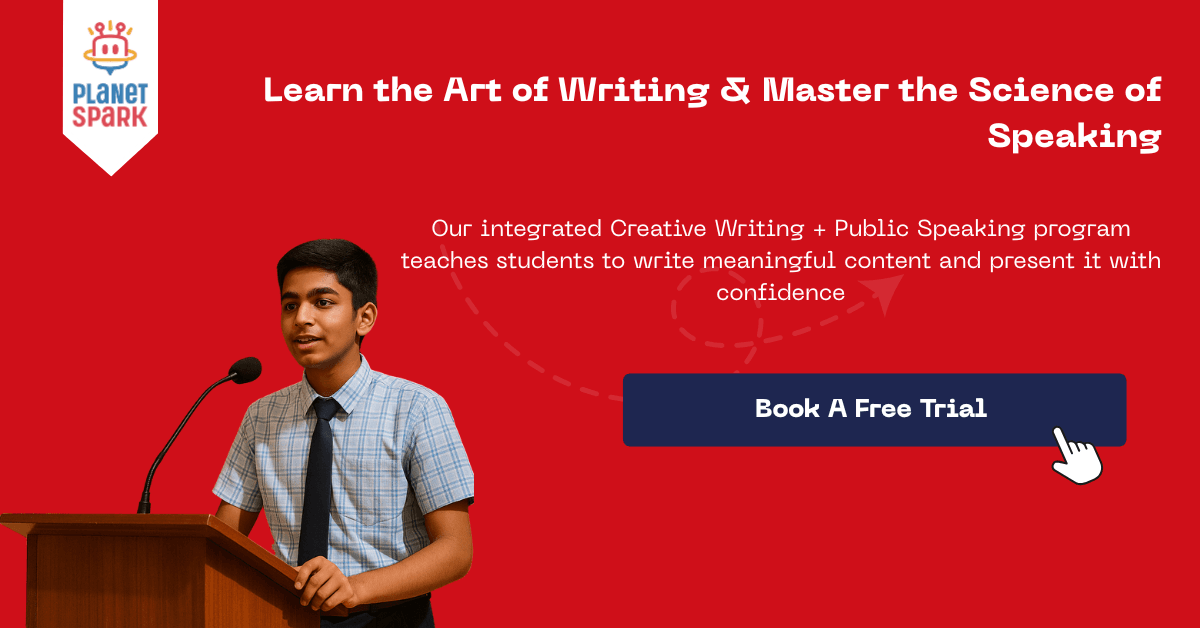Welcome Speech for Students with Tips & Sample Guide

Whether it’s the opening of a school function or a student competition, the welcome speech is the anchor that sets the tone for everything that follows. For students, it’s more than just a formal greeting but a chance to create a positive first impression and expressing the essence of an event by setting a confident stage presence.
At PlanetSpark, we believe that the ability to confidently deliver a powerful welcome speech is not just a talent it's a learnable skill. With our advanced Spoken English and Public Speaking courses, learners are equipped with everything they need to greet an audience with flair and professionalism.
What is a Welcome Speech?
A welcome speech is a short and formal address delivered to greet participants, guests, or dignitaries at the beginning of an event. It serves several purposes:
Greeting the audience warmly
Setting the tone and expectations
Highlighting the event’s purpose and significance
Expressing gratitude to attendees and organizers
It’s the first voice your audience hears so it needs to be clear, confident, and engaging.
How to Write a Welcome Speech
Writing a welcome speech can feel daunting, especially when you're trying to strike the right tone, engage the audience, and keep it concise. Follow these easy steps to start writing welcome speech in a warm, effective, and memorable welcome speech:
Step 1: Start with a Greeting
Begin with a courteous and inclusive greeting. The goal is to instantly build a connection with your audience. You can use:
“Good morning everyone” or “Honourable guests, respected teachers, and dear students…”
Step 2: State the Purpose of the Event
In 1–2 lines, clearly explain why the audience has gathered. This helps set the tone and context. For example:
“We are gathered here to celebrate the achievements of our students.”
“This evening marks the inauguration of our school’s science exhibition.”
Step 3: Acknowledge Guests and Contributors
If there are any chief guests, dignitaries, or special contributors, mention them by name (if appropriate) and welcome them warmly:
“We are honoured to have [Guest’s Name], [Designation], with us today.”
“A heartfelt thank you to our organizing team for making this day possible.”
Step 4: Express Excitement and Set Expectations
This builds anticipation and engagement. Give your audience a preview of what’s to come:
“We have a lineup of exciting performances and insightful talks ahead.”
“Today’s session will offer a unique perspective on…”
Step 5: Keep the Tone Appropriate
Match your language and formality to the audience and occasion. A school event may allow for a lighter tone, while a corporate function may require more formality.
Step 6: Conclude with Positivity
End on a gracious note by thanking the audience and wishing the event well:
“Thank you all for being here. Let’s make this event a memorable one.”
“Wishing everyone an inspiring and joyful evening ahead!”
Want to Write the Perfect Welcome Speech?
Join PlanetSpark’s Creative Writing + Public Speaking course and learn how to write impactful speeches step-by-step from structure to storytelling.
Key Elements of a Great Welcome Speech
Here are the core elements that make a welcome speech impactful:
A Warm Opening: Start with a heartfelt greeting that makes the audience feel acknowledged. A simple “Good morning, everyone!” delivered with a smile can work wonders.
Purpose of the Event: Briefly describe the purpose of the event and its importance. This gives the audience context and helps them stay engaged.
Acknowledge Dignitaries or Guests: If the event includes special guests, it’s courteous to mention and welcome them specifically.
Engage With the Audience: Make the audience feel like a part of the event. Use inclusive language like “we,” “our,” and “together.”
Keep It Concise: Time is precious, especially at formal events. A welcome speech should be short (usually 2–3 minutes) but impactful.
End With Positivity: Close the speech with an uplifting note, wishing the event success and thanking everyone for their presence.
Sample Welcome Speech for Students
“Good morning everyone,
On behalf of our school, it is my absolute pleasure to welcome you all to the Annual Day Celebration 2025. A special thank you to our respected Principal, dear teachers, proud parents, and all the wonderful students present here.
Today marks a celebration of talent, hard work, and creativity. It’s a day when we shine the spotlight on the achievements of our students not just in academics, but in art, sports, and innovation.
I hope this event brings joy, pride, and inspiration to us all. Without further ado, let’s begin the celebration. Thank you, and enjoy the day!”
Nervous About Speaking on Stage?
With PlanetSpark’s 1:1 Public Speaking Coaching, you’ll gain the confidence to deliver welcome speeches, extempore talks, and more with clarity and poise.Start Your Journey to Becoming a Confident Speaker with free demo classes
Tips to Fluently Deliver First Welcome Speech
Here are some simple but powerful tips to know to how to start a speech and prepare your first welcome speech:
Practice Aloud: Speaking aloud helps you become comfortable with the flow and identify difficult phrases.
Smile: A smile puts you and your audience at ease. It conveys warmth and confidence.
Maintain Eye Contact: Connect with the audience through your eyes, not just your words.
Use Gestures and Pause: Controlled hand movements and strategic pauses add power to your speech.
Know Your Audience: Tailor your tone, formality, and content depending on who’s listening.
How PlanetSpark Helps You Master the Welcome Speech
At PlanetSpark, our Spoken English and Public Speaking programs are meticulously designed to help students and professionals gain mastery over their verbal communication, especially in structured formats like welcome speeches.
Live, Interactive Spoken English Conversations- Unlike pre-recorded video courses, PlanetSpark provides live classes where learners practice welcome speeches and formal greetings in real-time with expert coaches.
TED-Style Public Speaking Training- Students learn to build impactful speeches using the hook–message–story–call-to-action model a proven format used by world-class speakers.
Voice Modulation and Articulation Techniques- Our trainers focus on clear pronunciation, voice projection, and accent neutralization critical for delivering welcome speeches confidently in English.
Situational Dialogues and Role Plays- Learners rehearse real-life speaking scenarios like welcoming a chief guest or addressing an audience through guided dialogues and stage simulations.
Video Feedback and AI Fluency Reports- Every speech delivery is recorded, analyzed, and reviewed. Our AI tools provide instant feedback on grammar, pronunciation, and pace so you always know what to improve.
Competitions and Speech Leagues- PlanetSpark hosts internal speech contests and national-level Public Speaking Leagues to help learners apply their skills in competitive environments.

Conclusion
A welcome speech may only last a few minutes, but its impact can last a lifetime. It reflects your confidence, clarity, and charisma. Whether you're a student preparing for a school event or an aspiring speaker wanting to overcome stage fear, PlanetSpark is your ultimate partner in your public speaking journey.
Frequently Asked Questions
Q1. What is a welcome speech?
A. A welcome speech is a short address delivered at the beginning of an event to greet guests, set the tone, and introduce the purpose of the gathering. It creates the first impression of the event and helps the audience feel included and informed.
Q2. How long should a welcome speech be?
A. Ideally, a welcome speech should be between 1 to 3 minutes long. It should be concise yet impactful long enough to greet the audience and outline the event, but short enough to keep their attention.
Q3. What should I include in a welcome speech?
A. great welcome speech should include:
A polite greeting
The purpose of the event
Acknowledgment of guests or dignitaries
A preview of what’s to come
A warm, positive closing
Q4. How can I make my welcome speech more engaging?
A. To make your welcome speech engaging:
Start with a smile and confident body language
Use storytelling or personal anecdotes (if appropriate)
Maintain eye contact and vary your voice tone
Practice beforehand to ensure smooth delivery
PlanetSpark helps you master these skills through real-time practice and expert coaching.
Q5. Can children deliver a welcome speech effectively?
A. With proper guidance and practice, children can deliver powerful welcome speeches. PlanetSpark’s Public Speaking and Spoken English courses provide structured support, helping kids build confidence, clarity, and expression.
Q6. Why is the welcome speech important in events?
A. The welcome speech sets the stage for the entire event. It offers a warm introduction, provides structure, and ensures that the audience feels acknowledged and engaged right from the start.
Personalized Communication Report
Record a video to get a AI generated personalized communication report for your child

Hi There, want to try these
tips for your child with
LIVE with our expert coach?
Let's check your child's
English fluency
